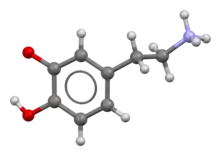Dopamine (medication)
Dopamine, sold under the brandname Intropin among others, is a medication most commonly used in the treatment of very low blood pressure, a slow heart rate that is causing symptoms, and, if epinephrine is not available, cardiac arrest.[3] In newborn babies it continues to be the preferred treatment for very low blood pressure.[4] In children epinephrine or norepinephrine is generally preferred while in adults norepinephrine is generally preferred for very low blood pressure.[5][6] It is given intravenously or intraosseously as a continuous infusion.[3] Effects typically begin within five minutes.[3] Doses are then increased to effect.[3]
 Skeletal formula of dopamine | |
 | |
| Clinical data | |
|---|---|
| Trade names | Intropin, Dopastat, Revimine, others |
| Other names | 2-(3,4-Dihydroxyphenyl)ethylamine; 3,4-Dihydroxyphenethylamine; 3-hydroxytyramine; DA; Intropin; Revivan; Oxytyramine; Prolactin inhibiting factor; Prolactin inhibiting hormone |
| AHFS/Drugs.com | Monograph |
| License data |
|
| Routes of administration | Intravenous injection |
| ATC code | |
| Physiological data | |
| Source tissues | Substantia nigra; ventral tegmental area; many others |
| Target tissues | System-wide |
| Receptors | D1, D2, D3, D4, D5, TAAR1[2] |
| Agonists | Direct: apomorphine, bromocriptine Indirect: cocaine, amphetamine |
| Antagonists | Neuroleptics, metoclopramide, domperidone |
| Metabolism | MAO, COMT,[2] ALDH, DBH, MAO-A, MAO-B, COMT |
| Legal status | |
| Legal status |
|
| Pharmacokinetic data | |
| Metabolism | MAO, COMT,[2] ALDH, DBH, MAO-A, MAO-B, COMT |
| Excretion | Kidney |
| Identifiers | |
| |
| CAS Number | |
| PubChem CID | |
| IUPHAR/BPS | |
| DrugBank | |
| ChemSpider | |
| UNII | |
| KEGG | |
| ChEBI | |
| ChEMBL | |
| Chemical and physical data | |
| Formula | C8H11NO2 |
| Molar mass | 153.181 g·mol−1 |
| 3D model (JSmol) | |
| Density | 1.26 g/cm3 |
| Melting point | 128 °C (262 °F) |
| Boiling point | decomposes |
| |
| |
| (verify) | |
Common side effects include worsening kidney function, an irregular heartbeat, chest pain, vomiting, headache, or anxiety.[3] If it enters into the soft tissue around the vein local tissue death may occur.[3] The medication phentolamine can be given to try to decrease this risk.[3] It is unclear if dopamine is safe to use during pregnancy or breastfeeding.[3] At low doses dopamine mainly triggers dopamine receptors and β1-adrenergic receptors while at high doses it works via α-adrenergic receptors.[3]
Dopamine was first synthesized in a laboratory in 1910 by George Barger and James Ewens in England.[7] It is on the World Health Organization's List of Essential Medicines.[8] In human physiology dopamine is a neurotransmitter as well as a hormone.[9]
Medical uses
Low blood pressure
In newborn babies it continues to be the preferred treatment for very low blood pressure.[4] In children epinephrine or norepinephrine is generally preferred while in adults norepinephrine is generally preferred for very low blood pressure.[5][6]
In those with low blood volume, this should be corrected with intravenous fluids before dopamine is considered.[3]
Kidney function
Low-dosage dopamine has been routinely used for the treatment and prevention of acute kidney injury. However, since 1999 a number of reviews have concluded that doses at such low levels are not effective and may sometimes be harmful.[10][11]
Administration
Since the half-life of dopamine in plasma is short—approximately one minute in adults, two minutes in newborn babies and up to five minutes in preterm babies—it is usually given as a continuous intravenous drip rather than a single injection.[12]
Other
A fluorinated form of L-DOPA known as fluorodopa is available for use in positron emission tomography to assess the function of the nigrostriatal pathway.[13]
Contraindications
Dopamine should generally not be given to people who have a pheochromocytoma or uncorrected very fast heart rate.[3]
Side effects
The LD50, or dose which is expected to prove lethal in 50% of the population, has been found to be: 59 mg/kg (mouse; administered intravenously); 950 mg/kg (mouse; administered intraperitoneally); 163 mg/kg (rat; administered intraperitoneally); 79 mg/kg (dog; administered intravenously).[14]
Extravasation
If extravasation occurs local tissue death may result.[3] The medication phentolamine can be injected at the site to try to decrease the risk of tissue death.[3]
Mechanism of action
Its effects, depending on dosage, include an increase in sodium excretion by the kidneys, an increase in urine output, an increase in heart rate, and an increase in blood pressure.[12] At low doses it acts through the sympathetic nervous system to increase heart muscle contraction force and heart rate, thereby increasing cardiac output and blood pressure.[15] Higher doses also cause vasoconstriction that further increases blood pressure.[15][16]
While some effects result from stimulation of dopamine receptors, the prominent cardiovascular effects result from dopamine acting at α1, β1, and β2 adrenergic receptors.[17][18]
References
- Cruickshank, Laura; Kennedy, Alan R.; Shankland, Norman (2013). "Tautomeric and ionisation forms of dopamine and tyramine in the solid state". J. Mol. Struct. 1051: 132–136. doi:10.1016/j.molstruc.2013.08.002.
- "Dopamine: Biological activity". IUPHAR/BPS guide to pharmacology. International Union of Basic and Clinical Pharmacology. Archived from the original on 5 February 2016. Retrieved 29 January 2016.
- "Dopamine Hydrochloride". drugs.com. American Society of Health-System Pharmacists. June 29, 2016. Archived from the original on 14 September 2016. Retrieved 15 July 2016.
- Bhayat, SI; Gowda, HM; Eisenhut, M (8 May 2016). "Should dopamine be the first line inotrope in the treatment of neonatal hypotension? Review of the evidence". World Journal of Clinical Pediatrics. 5 (2): 212–22. doi:10.5409/wjcp.v5.i2.212. PMC 4857235. PMID 27170932.
- De Backer, D; Aldecoa, C; Njimi, H; Vincent, JL (March 2012). "Dopamine versus norepinephrine in the treatment of septic shock: a meta-analysis*". Critical Care Medicine. 40 (3): 725–30. doi:10.1097/ccm.0b013e31823778ee. PMID 22036860. S2CID 24620964.
- Dellinger, RP; Levy, MM; Rhodes, A; Annane, D; Gerlach, H; Opal, SM; Sevransky, JE; Sprung, CL; Douglas, IS; Jaeschke, R; Osborn, TM; Nunnally, ME; Townsend, SR; Reinhart, K; Kleinpell, RM; Angus, DC; Deutschman, CS; Machado, FR; Rubenfeld, GD; Webb, SA; Beale, RJ; Vincent, JL; Moreno, R; Surviving Sepsis Campaign Guidelines Committee including the Pediatric, Subgroup (February 2013). "Surviving sepsis campaign: international guidelines for management of severe sepsis and septic shock: 2012". Critical Care Medicine. 41 (2): 580–637. doi:10.1097/CCM.0b013e31827e83af. PMID 23353941. S2CID 34855187.
- Fahn S (2008). "The history of dopamine and levodopa in the treatment of Parkinson's disease". Movement Disorders. 23 Suppl 3: S497–508. doi:10.1002/mds.22028. PMID 18781671. S2CID 45572523.
According to Hornykiewicz,6 dopamine was first synthesized by George Barger and James Ewens in 1910 at the Wellcome labs in London, England.
- World Health Organization (2019). World Health Organization model list of essential medicines: 21st list 2019. Geneva: World Health Organization. hdl:10665/325771. WHO/MVP/EMP/IAU/2019.06. License: CC BY-NC-SA 3.0 IGO.
- Millar, Thomas (2002). Biochemistry explained : a practical guide to learning biochemistry. London: Routledge. p. 40. ISBN 9780415299411. Archived from the original on 2016-08-15.
- Karthik S, Lisbon A (2006). "Low-dose dopamine in the intensive care unit". Seminars in Dialysis. 19 (6): 465–71. doi:10.1111/j.1525-139X.2006.00208.x. PMID 17150046. S2CID 22538344.
- Power, DA; Duggan, J; Brady, HR (April 1999). "Renal-dose (low-dose) dopamine for the treatment of sepsis-related and other forms of acute renal failure: ineffective and probably dangerous". Clinical and Experimental Pharmacology & Physiology. Supplement. 26: S23–8. PMID 10386250.
- Bhatt-Mehta V, Nahata MC (1989). "Dopamine and dobutamine in pediatric therapy". Pharmacotherapy. 9 (5): 303–14. doi:10.1002/j.1875-9114.1989.tb04142.x. PMID 2682552. S2CID 25614283.
- Deng WP, Wong KA, Kirk KL (2002). "Convenient syntheses of 2-, 5- and 6-fluoro- and 2,6-difluoro-L-DOPA". Tetrahedron: Asymmetry. 13 (11): 1135–1140. doi:10.1016/S0957-4166(02)00321-X.
- Lewis RJ (2004). Sax's Dangerous Properties of Industrial Materials, 11th Ed. Hoboken, NJ.: Wiley & Sons. p. 1552. ISBN 978-0-471-47662-7.
- Bronwen JB, Knights KM (2009). Pharmacology for Health Professionals (2nd ed.). Elsevier Australia. p. 192. ISBN 978-0-7295-3929-6.
- De Backer D, Biston P, Devriendt J, Madl C, Chochrad D, Aldecoa C, Brasseur A, Defrance P, Gottignies P, Vincent JL (2010). "Comparison of dopamine and norepinephrine in the treatment of shock". The New England Journal of Medicine. 362 (9): 779–89. doi:10.1056/NEJMoa0907118. PMID 20200382.
- Moses, Scott. "Dopamine". Family Practice Notebook. Archived from the original on 1 February 2016. Retrieved 1 February 2016.
Dopamine binds to alpha-1 and beta-1 adrenergic receptors. Mediated through myocardial beta-1 adrenergic receptors, dopamine increase heart rate and force, thereby increasing cardiac output. Alpha-1 adrenergic receptor stimulation on vascular smooth muscle, leads to vasoconstriction and results in an increase in systemic vascular resistance
- Katritsis, Demosthenes G.; Gersh, Bernard J.; Camm, A. John (19 September 2013). Clinical Cardiology: Current Practice Guidelines. OUP Oxford. p. 314. ISBN 9780191508516. Archived from the original on 6 May 2016.
Dopamine binds to beta-1, beta-2, alpha-1 and dopaminergic receptors.